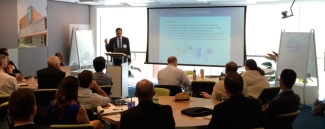<p>Over 60 attendees gathered at USGBC headquarters on July 11 to advance microgrids in Washington, D.C. USGBC and <a href="http://www.gbci.org/" target="_blank">GBCI</a>, together with <a href="http://www.urbaningenuity.com/" target="_blank">Urban Ingenuity</a>, led discussions for government officials, utility representatives, technologists and project developers focusing on what microgrids and district energy systems involve and how to build them.</p>
<blockquote><p>DC has almost 700 <a href="https://twitter.com/hashtag/LEED?src=hash">#LEED</a> projects. Will your project be the first <a href="https://twitter.com/PEERCertified">@PEERCertified</a>? <a href="https://twitter.com/hashtag/microgridsinDC?src=hash">#microgridsinDC</a…; <a href="https://twitter.com/hashtag/sustainableDC?src=hash">#sustainableDC</a><…;
<p>— Jay Wilson (@JayW47) <a href="https://twitter.com/JayW47/status/752527301682814976">July 11, 2016</a></p></blockquote>
<p>Department of Energy and Environment (DOEE) Director Tommy Wells highlighted the program and noted that because 50 percent of the world’s population lives in cities and 70 percent of greenhouse gases come from cities, municipal leaders must do all they can to prevent environmental damage, including advance programs, funding and regulation favorable to microgrid development. Senior staff from DOEE then laid out the steps in getting started:</p>
<ol>
<li>Identify the microgrid project site</li>
<li>Ensure all legal and regulatory aspects are supportive</li>
<li>Secure project finance and begin implementation </li>
</ol>
<blockquote><p>MT <a href="https://twitter.com/jamiestatter">@jamiestatter</a>: Dir Wells of <a href="https://twitter.com/DOEE_DC">@DOEE_DC</a> kicks off day <a href="https://twitter.com/USGBC">@USGBC</a> on <a href="https://twitter.com/hashtag/microgridsinDC?src=hash">#microgridsinDC</a…; <a href="https://twitter.com/hashtag/sustainableDC?src=hash">#sustainableDC</a> and <a href="https://twitter.com/PEERCertified">@PEERCertified</a> <a href="https://t.co/qR4QblGwzT">pic.twitter.com/qR4QblGwzT</a></p>
<p>— DC Energy & Env. (@DOEE_DC) <a href="https://twitter.com/DOEE_DC/status/752512107128684544">July 11, 2016</a></p></blockquote>
<p>Two powerful tools assist in these steps for microgrid development: Attendees were shown how these tools work with a case study at D.C.’s Gallaudet University. Urban Ingenuity’s microgrid feasibility scoring system produces a quantification of how well a project site is situated for microgrid development, based upon what existing infrastructure is present, what government and utility regulations are present and the goals of the owner and customer. </p>
<p><a href="http://peer.gbci.org/" target="_blank">PEER</a> is the first certification system for sustainable power systems. The PEER Assessment Tool produces a foundation of project operation costs and how to optimize system design and operation. Further engagement with PEER allows access to specialized analysis tools to gain the most points in certification in its four categories: Energy and Environment, Reliability and Resiliency, Operational Effectiveness and Customer Contribution.</p>
<p>The enthusiasm surrounding microgrids is not limited to Washington, D.C., however. Look for similar workshops in your region in the future.</p>
<p><a href="http://peer.gbci.org/" target="_blank" class="button">Learn more about PEER</a></p>
<!-- BEGIN KAPOST ANALYTICS CODE --><script type="text/javascript">
<!--//--><![CDATA[// ><!--
<!--
var _kaq = _kaq || [];
_kaq.push([2, "578f89f23e45d1144a000294", "5790d4d8f8fdd808b50001de"]);
(function(){
var ka = document.createElement('script'); ka.async=true; ka.id="ka_tracker"; ka.src="http://analytics.kapost.com/ka.js";
var s = document.getElementsByTagName('script')[0]; s.parentNode.insertBefore(ka, s);
})();
//-->
//--><!]]>
</script><!-- END KAPOST ANALYTICS CODE -->
